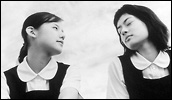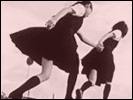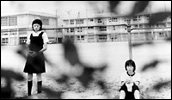Blue
- Year
- 2003
- Original title
- Blue
- Japanese title
- blue
- Director
- Cast
- Running time
- 116 minutes
- Published
- 21 May 2003



by Jasper Sharp
Let me first start off by saying that Blue is not a particularly good film. It won't go on general release outside of Japan. I doubt it will play any but the most minor of international festivals - though apparently it has already won a Best Actress prize at Moscow for one of its young starlets, Mikako Ichikawa. It's hardly the stuff cult followings are made of either, so don't hold your breath waiting for word of mouth to spread on the underground circuit. Even on a Friday night on its second week at Shibuya's independent Cine Amuse, the only venue in Tokyo it seems to be screening, there wasn't that much in the way of local turnout. In fact, aside from a few industry insiders who might get handed a screener tape to pass comment on, I doubt any reader here will ever even get the chance to see it.
For this reason, I almost wasn't going to bother reviewing it, were it not for the fact that it is so indicative of the current flailing state of the Japanese film industry that I believe it is worthy of picking over the carcass. If I don't, those outside Japan may continue to believe that the likes of Battle Royale, Not Forgotten, Ring, and Dead Or Alive - the type of films that prompted us to start Midnight Eye in the first place - represent the norm as opposed to the exception to the type of local product that more typically plays the screens of Tokyo. It gives me no pleasure, believe me. We came here to praise Japanese cinema, not to bury it, but after a long row of duds, I'm beginning to wonder if I'm going to see anything this year to get excited about. The sad fact is, Japanese independent cinema currently seems to have become reliant for its survival upon the same crowd of loyal devotees who dutifully trudge out to the same handful of single screen late night independent cinemas to catch the latest work - proudly displaying the name of the obscure international festival where it won its same obscure award over a year ago - made by the same handful of directors and utilising the same handful of actors and actresses. Budgets are getting tighter, audiences are getting thinner and I hate to say it, but the quality is getting markedly lower.
So for this reason I came out of Blue, feeling, well, rather blue. On paper it had seemed an attractive position: an adaptation of a manga of the same name by Kiriko Nananan which had come highly praised from some sources for its strikingly bold yet simple design, popular amongst art school students and professionals working in the creative fields, a shoujo manga (girls comic) for those who'd left the rococo swirls and pastel shades of "Margaret" and "Rose of Versailles" way behind them.
Admittedly, the story, a subtle tale of same-sex infatuation in the pristine uniformed world of a high school for girls, was nothing new in the world of girls comics. As cultural commentators such as Frederick Schodt, Ian Buruma, and Nicholas Bornoff have pointed out, the long and rigid timetables of the average Japanese high school student leave little scope for romantic exploration outside of school hours, and hence, at an age when hormones are starting to stir, these natural urges find their outlet in dreamy-eyed yet otherwise chaste homoerotic fantasies set in such exotic and safely distant locales as European boys public school dormitories - in the 70s and 80s at least. As Buruma puts it in his book, A Japanese Mirror: Heroes and Villains of Japanese Culture (a.k.a. Behind the Mask); 'Possibly many young girls - and to a lesser extent young boys - feeling that their natural inclinations are being slowly crushed by an adult world that forces them to be calculating and conformist, find an outlet in homosexual fantasies too remote from their own lives to be threatening: a far-away romantic ideal like the "Paris of our dreams"'.
Blue's main appeal was that it fell just that one step short of the fantasy by setting its tale in a more recognisable locale situated slightly closer to home, in a high school for girls set beside the sea. By fixing its tale in an unattainable past however, it still managed to keep the full force of its nature just as safely far at bay as if it were the other side of the world. Nevertheless, the milieu was recognisable enough to have a good deal of resonance with readers, taking a misty-eyed nostalgic look back at the time when an innocent girl-girl friendship had the potential to go beyond innocent hand-holding were it not for the restrictive pressures of conformity - the film's tag line "Koibito ga dekiru made" ("until it is possible to be lovers") evokes the feeling of wistful yearning explicitly.
A new girl named Endo arrives in class, and straight away becomes the object of the gaze of sullen, pubertal Kirishima for the duration of those long and arduous geography lessons. The two become friends, finding themselves spending increasingly more time along together, after having split away from the herd of young fawns with whom they regularly shared their daily lunchbox on the school roof. From then on things escalate quickly - a borrowed Aztec Camera CD (in the 21st century???), the shared frisson of a slight brush of skin on the school bus, going gooey gazing over books of Cezanne paintings in the elfin Endo's bedroom, and moments of eye contact held just one or two heartbeats too long. From then on, after a teary Kirishima opens her heart to Endo, and the two share a nervous twilight kiss on the deserted beach near their school, it's a standard tale of girl-meets-girl-girl-loses-girl-girl-gets-girl-back-only-to-find-that-she-is-soon-leaving-for-the-big-city-and-shall-remain-as-elusive-as-she-ever-did-and-oh-what-a-pity-but-at-least-we-have-our-memories.
As a film, Blue already has two tales of young homosexual love to compete with, in the form of Ryosuke Hashiguchi's Like Grains of Sand (1995) and Kaze Shindo's Love/Juice (2000), and as such, has nothing more to offer that these two haven't already given us. Which is fair enough. What marked Nananan's comic out was its minimalist visuals, rather than radical plot subversion. Unlike your average high school girl today, or come to think of it, the protagonists of the shoujo manga her generation were weaned on, Nananan's girls all had black hair and all wore their finely starched pinafore dresses way beyond the knee. Their facial details were deliberately left vague, as if for the readers to project their own fantasies upon. Obviously appropriating such a style for cinema is difficult - giving the viewer enough material to work with whilst allowing enough scope for their own imagination to do all the work. Increasingly Shinji Aoyama's Eureka seems to have become the template for those with an eye on the international art house market, and director Ando, who seems to have come from a background of straight-to-video porno with a filmography that largely consists of such titles as Shin Chikan Nikki (trans. New Pervert Diary, Toei Video, 1999), sticks with this style - long static tableaux in which very little happens, a virtual absence of music on the soundtrack and in fact nothing very much for the viewer to work with at all.
Now, if there is anyone who thinks that there is anything more to be said with this approach that Aoyama hasn't already managed in the near four hours of his film, then by all means, go ahead and sit through Blue. But most of us, I fear, will just find it excruciatingly boring. Reduced to a series of still shots, Blue has some nice images, but that's about as far as it goes. Scenes drag on for eternity with no narrative purpose. There's one scene where after a terse exchange with a classmate, Kirishima (or maybe it was the other one - it really doesn't matter) walks away from the camera back to the classroom across the school playground - the school building is about 300 meters away, and Ando wants us to be present every step of the way. As an isolated moment, perhaps as a comedown for the audience to gather their thoughts after some dramatic highpoint, it may have been effective, but unfortunately the entire two-hour running time is filled with such moments. Time and time again this complete inability by Japanese directors to pace a film properly has been noted - even such potentially commercial fair as Shall We Dance? or GO lag in their final quarters. It is markedly more exacerbated in a film like Blue, in which nothing actually happens. And of course, the presence of Ichikawa doesn't help when you suddenly recall that this is her second film after debuting in possibly the worst offender in these stakes, Hiroshi Okuhara's patience-trying Timeless Melody.
It doesn't help that Blue is so obviously a victim of a miniscule budget. Several scenes are underlit, and no one seems to have bothered with sound mixing at all. The dialogue is so remarkably unnatural sounding, you can practically see the speech bubbles above the actresses heads. But Swedish director Lukas Moodysson also had a tiny budget for the similarly themed Show Me Love (Fucking Amal, 1998). Perhaps were Ando to have Moodysson's humour and eye for drama then we might have something to recommend in Blue. Until then, I suggest Ando sticks to the colour pink, not blue, and the rest of us should stick with Nananan's manga.